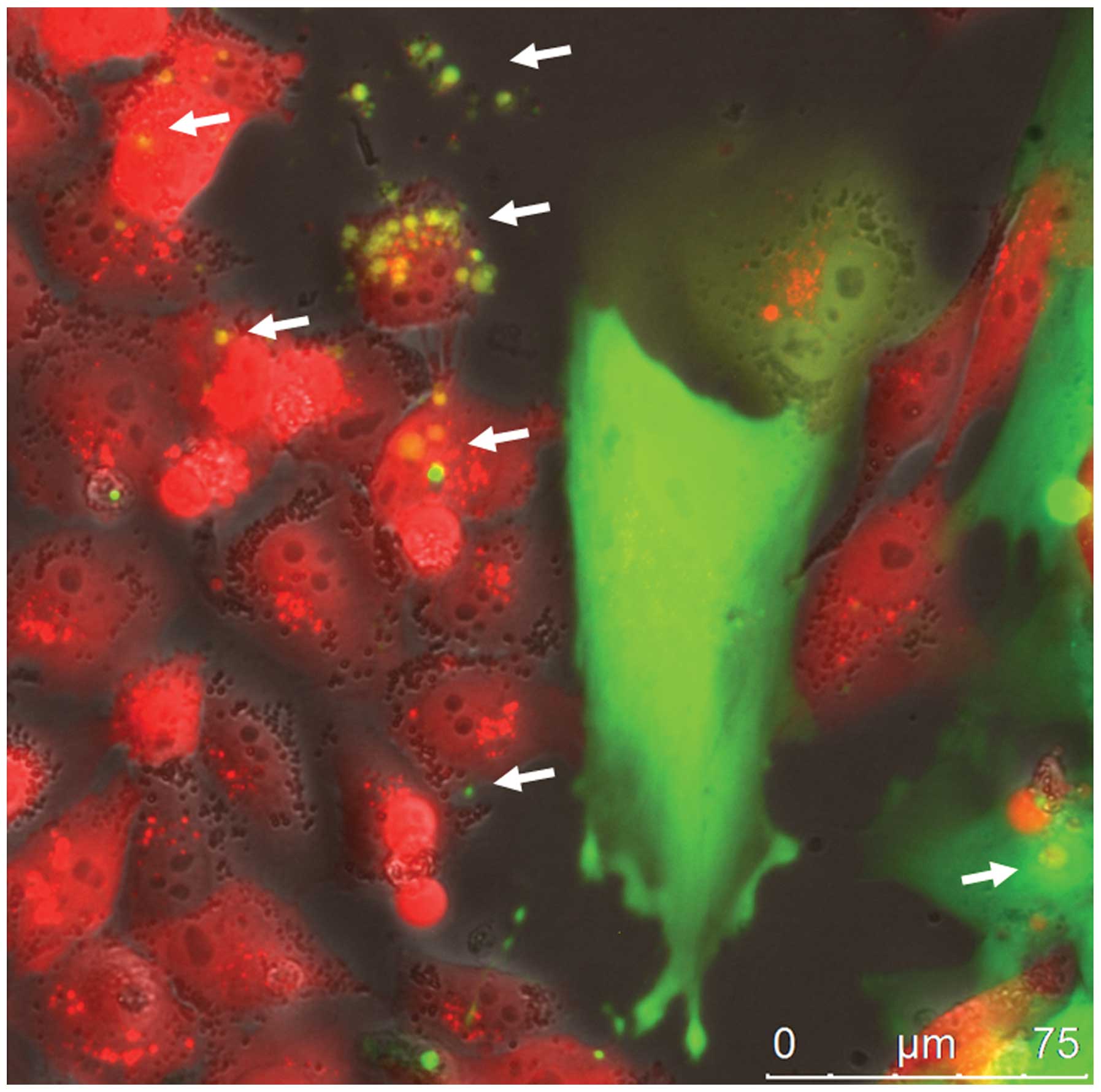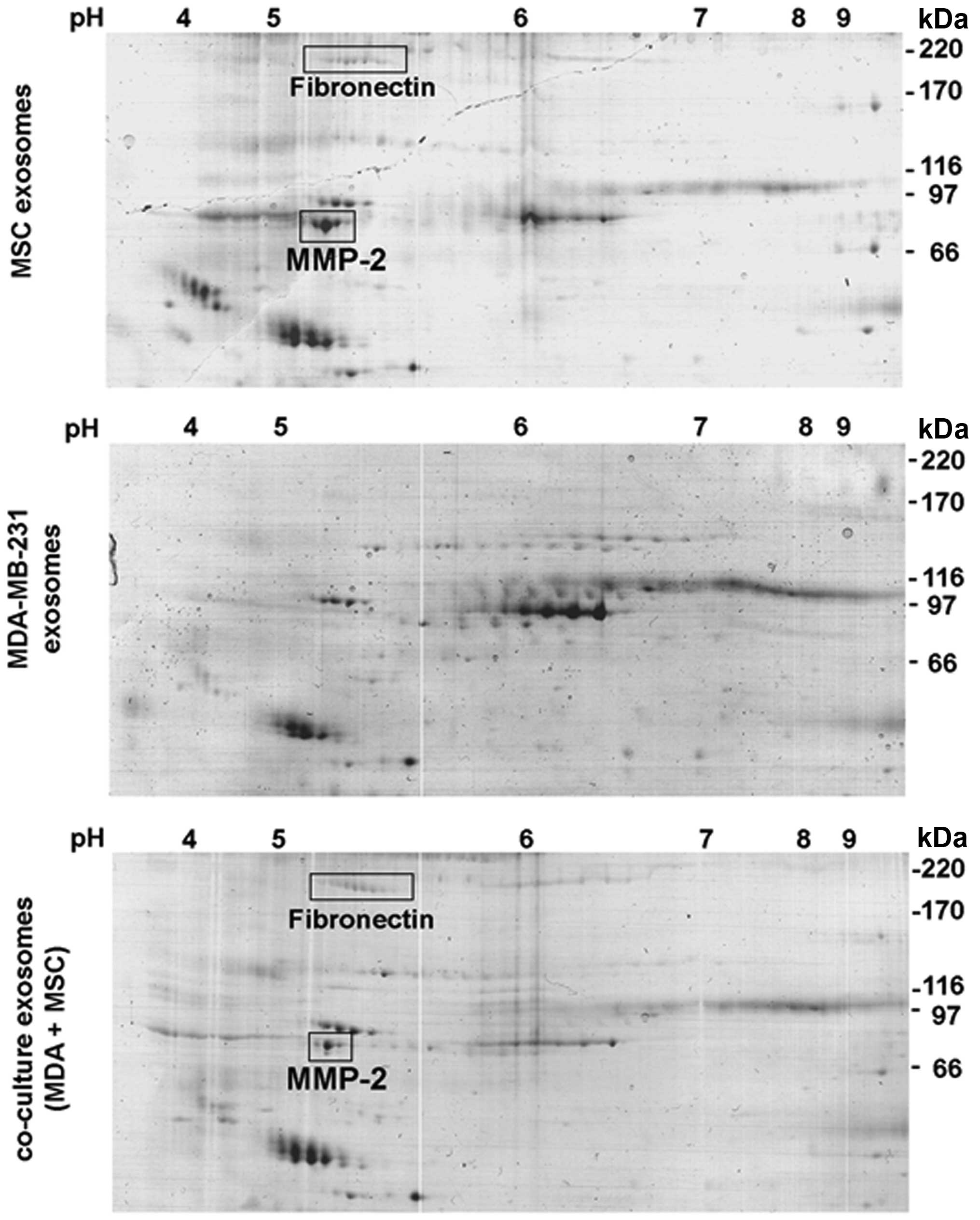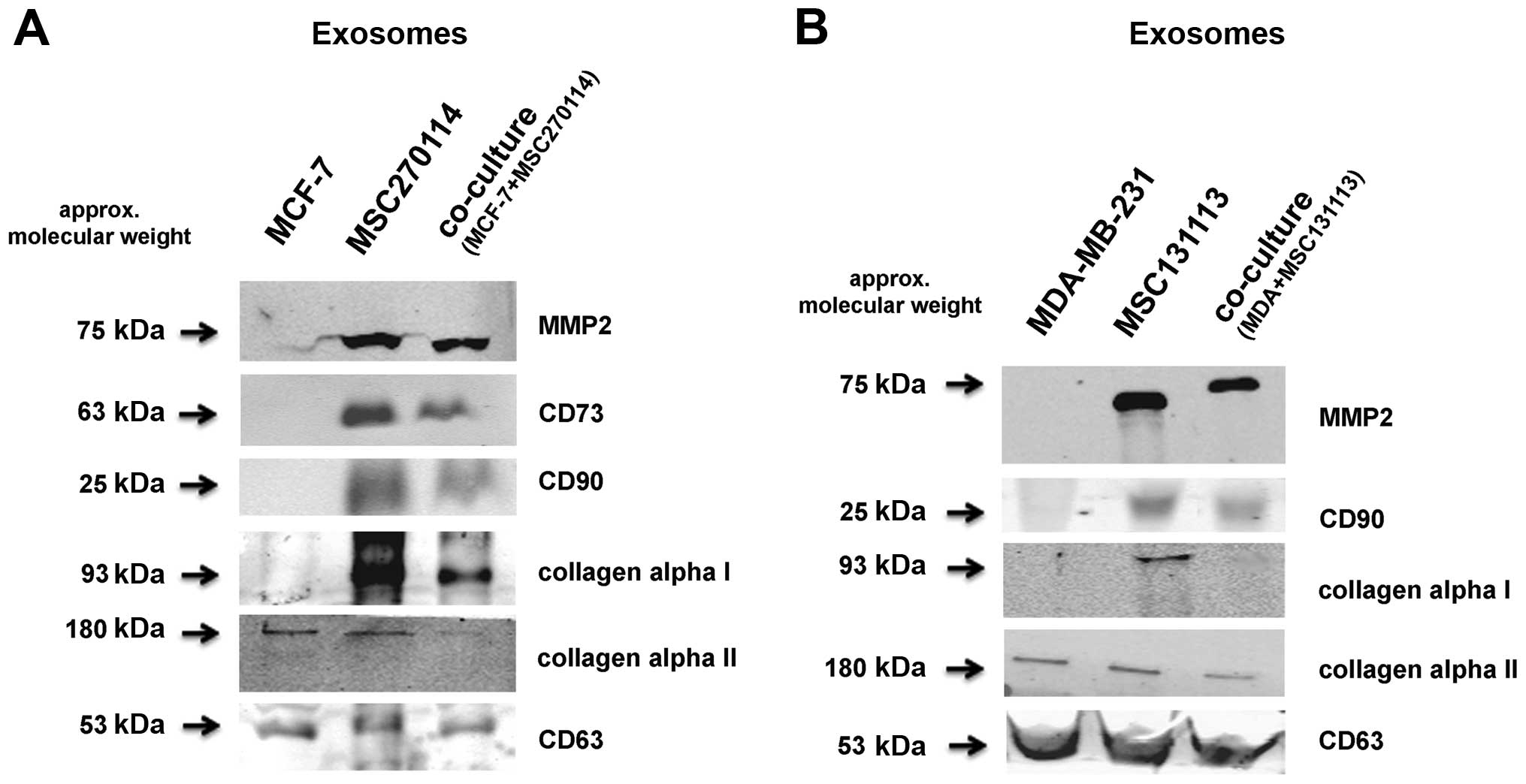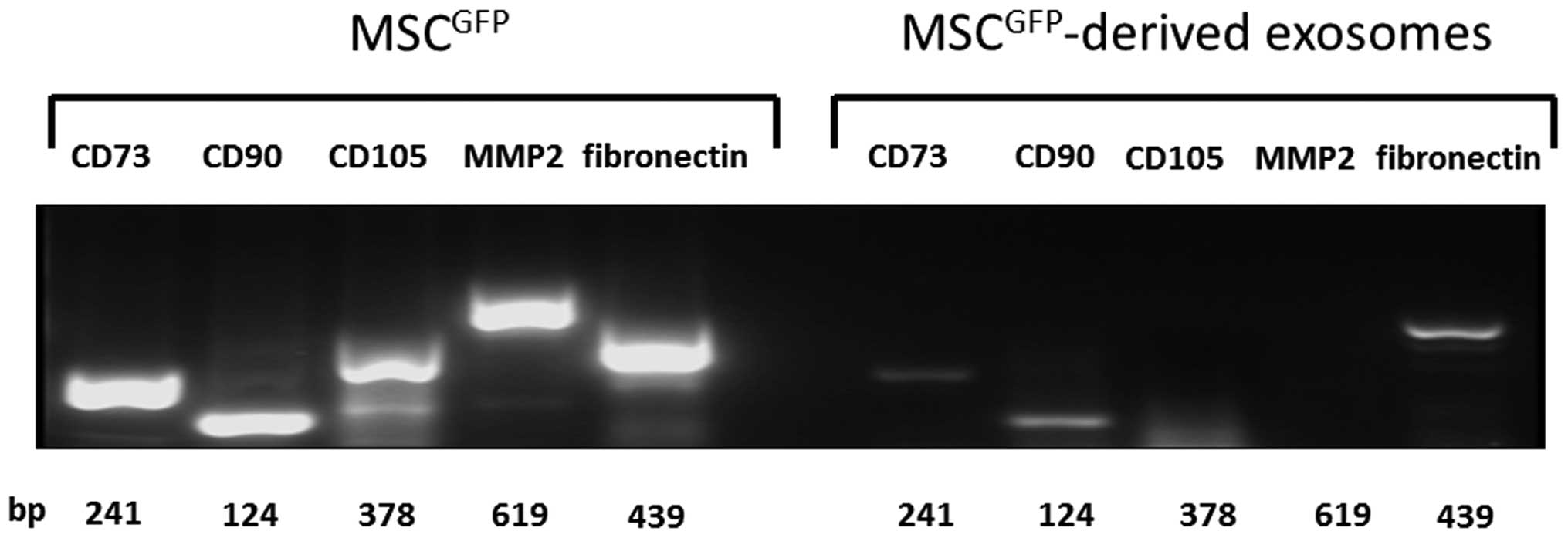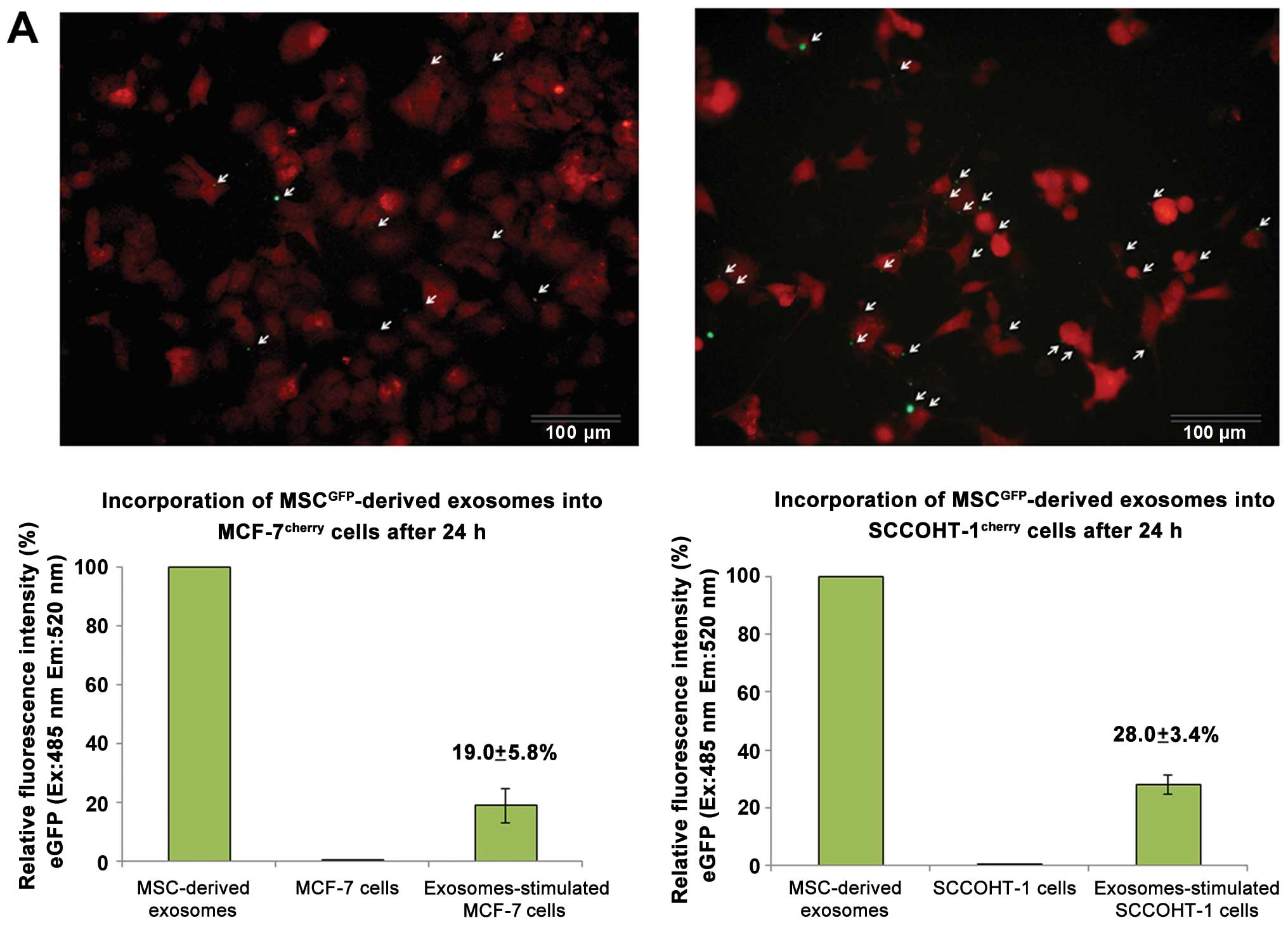Acquisition of new tumor cell properties by MSC-derived exosomes
- Authors:
- Published online on: May 11, 2015 https://doi.org/10.3892/ijo.2015.3001
- Pages: 244-252
Abstract
Introduction
Multipotent human mesenchymal stroma/stem cells (MSC) are characterized as a heterogeneous cell population which can be found in nearly all vascularized organs and tissues. The stem cell properties include self-renewal and regenerative potential (1). Moreover, MSC display at least a tri-lineage differentiation capacity along the osteogenic, chondrogenic and adipogenic phenotype (2). Certain heterogeneity in morphology and cell fate as demonstrated by isolation of MSC subpopulations (3) may result partially from the cellular microenvironment by neighboring cells, altered trophic factors, pH or hypoxic conditions. Consequently, a broad range of simultaneous properties including the capacity for plastic adherence, paralleled by expression of the CD73, CD90 and CD105 surface molecules with concomitant absence of other cell type-specific markers including CD14, CD31, CD34 CD45 and HLA-DR can be identified for MSC (2,4).
MSC are recruited during tissue damage to support wound repair and tissue regeneration. Likewise, invasive tumor growth also causes tissue injuries and inflammatory processes with the consequence of MSC attraction and cellular crosstalk. MSC can interact with tumor cells via exchange of soluble factors like chemokines, cytokines and further trophic molecules as well as various microvesicles including exosomes. These types of interaction enable multiple pathways for MSC to communicate with neighboring tumor cells whereby release of exosomes can also affect more distant tumor cells. Exosomes represent small membrane particles of endocytic origin which are released into the extracellular compartment (5) and contain a large panel of proteins, mRNAs and regulatory microRNAs (miRs) which can alter the functionality of recipient cells (6). According to the heterogeneity of MSC populations, exosomes from MSC of different tissue origin contain a variety of unique proteins together with some common exosomal marker proteins such as CD29 or CD63 (7,8). Several effects of MSC-derived exosomes on tumor cells have been demonstrated including suppression of angiogenic potential by down-modulation of VEGF in breast cancer cells via exosome-associated miR-16 (9). Moreover, human umbilical cord MSC-derived exosomes can protect against cisplatin-induced nephrotoxicity and promote cell proliferation (10) and other research has demonstrated that human bone marrow MSC-derived exosomes increase tumor growth in vivo (11), however, mechanisms for these findings remain unclear.
In the present study, we investigated the effects of MSC-derived exosomes on different tumor types including breast cancer and a rare type of ovarian carcinoma cells. The data demonstrated a variety of functional changes including MMP-2 and ecto-5′-nucleotidase acquisition by different tumor cells following internalization of exosomes.
Materials and methods
Cell culture of mesenchymal stem/stroma cells (MSC)
Primary human mesenchymal stem cells were obtained after explant culture of umbilical cord tissue; the procedure was approved by the Ethics Committee of Hannover Medical School, Project no. 443, February 26, 2009, respectively, following informed written consent by the patient.
MSC-like cells were isolated from human umbilical cords as reported previously (12). The cells were obtained from different patients following delivery of full-term (38–40 weeks) infants either spontaneously or by cesarean section. In brief, umbilical cord tissue was washed with PBS to remove blood cells, cut into ~0.5 cm3 large pieces and incubated in αMEM (Sigma Chemie GmbH, Steinheim, Germany) supplemented with 15% of allogeneic human AB-serum (HS; commercially obtained from blood bank, University Campus Lübeck, Germany), 100 U/ml penicillin, 100 μg/ml streptomycin and 2 mM L-glutamine (Sigma) at 37°C in a humidified atmosphere with 5% CO2. After ~14 days of explant culture, the umbilical cord tissue pieces were removed and the adherent cells were harvested by accutase (Sigma) treatment for 3 min at 37°C. The obtained cell suspension was centrifuged at 320 × g for 5 min and the cells were resuspended in MSC culture medium (αMEM supplemented with 10% HS, 100 U/ml penicillin, 100 μg/ml streptomycin and 2 mM L-glutamine) and subcultured in the appropriate passage. For the experiments, MSC primary cultures from 5 different donors in different passages (P1 to P5) were used (MSC241111 in P3, MSC131113 in P2, MSC101213 in P1 and P3, MSC180314 in P5 and MSC270114 in P1), respectively.
Cell culture of tumor cells
Human MDA-MB-231 and MCF-7 breast carcinoma cell lines were obtained from the American Type Culture Collection (Rockville, MD, USA). MCF-7 cells were grown in Dulbecco’s modified Eagle’s medium and MDA-MB-231 cells were cultured in Leibovitz medium supplemented with [10% (v/v) fetal calf serum, 2 mM L-glutamine, 100 U/ml penicillin and 100 mg/ml streptomycin] (all from Sigma Chemie GmbH, Steinheim, Germany), respectively. Subculture was performed by trypsin/EDTA (Biochrom GmbH, Berlin, Germany) treatment for 5 min at 37°C.
SCCOHT-1 cells represent a spontaneously proliferating population derived from a patient with recurrent small cell carcinoma of the ovary hypercalcemic type (SCCOHT) and were maintained in RPMI-1640 with medium supplements as described previously (13).
Cells were cultivated at 37°C in a humidified atmosphere containing 5% CO2 and tested for mycoplasma by the luminometric MycoAlert Plus mycoplasma detection kit (Lonza Inc., Rockland, ME, USA) according to the manufacturer’s recommendations. Moreover, authentication of the cell lines was performed by short tandem repeat (STR) fragment analysis using the GenomeLab human STR primer set (Beckman Coulter Inc., Fullerton, CA, USA) demonstrating similar STR pattern according to the STR database provided by the Deutsche Sammlung von Mikroorganismen und Zellkulturen (DSMZ, Braunschweig, Germany).
Labeling of MSC by lentiviral transduction
For discrimination of the different tumor cells in co-culture with MSC and for proliferation measurements, all tumor cell populations were transduced with a 3rd generation lentiviral SIN vector containing the mcherry gene. Likewise, the different MSC populations were transduced with a 3rd generation lentiviral SIN vector containing the eGFP gene according to a labeling technique previously described (14).
Analysis of surface markers by flow cytometry
Characterization of the MSC immunophenotype was performed as described previously (15). Briefly, continuously proliferating MSC were harvested and analyzed for cell surface marker expression by flow cytometry. After blocking non-specific binding to Fc-receptors by incubation of 106 cells with 2% FCS for 30 min at 4°C and washing with PBS-BSA, the cells were incubated with the following appropriately-labeled monoclonal anti-human antibodies, respectively: CD73-PE (clone AD2) (BD Bioscience); CD90-PE (clone 5E10, IgG1, BioLegend Inc., San Diego, CA, USA); CD105-PE (clone 43A3, IgG1, BioLegend Inc.); CD31-FITC (Miltenyi Biotec, Bergisch-Gladbach, Germany); CD34-PE and CD45-PE (BD Biosciences). Following antibody staining, all samples were washed twice with PBS-BSA. Positive staining was obtained according to control measurements of the different populations with isotype-matching IgG control antibodies. Flow cytometry analysis and histograms were performed in a Galaxy FACSan (Partec) using FloMax analysis software (Partec).
Preparation of exosomes
Exosomes were isolated using the total exosome isolation kit reagent (Invitrogen, USA). After culture in serum-free conditions for 24 h, cell media were harvested from MSCGFP, MCF-7cherry, and MDA-MB231cherry mono-cultures and from co-cultures of MSC with the two breast cancer cell lines, respectively. Co-culture of MSC and the tumor cells was performed at a cell ratio of 60:40. The cells were cultured at an initial density of 2,000 cells/cm2 for 7–15 days and following medium exchange with serum-free media, the released exosomes were isolated after subsequent 24 h.
The serum-free cell media samples were centrifuged at 2,000 × g for 30 min to remove cell debris. The supernatant was stored on ice and supplemented with the half volume of the total exosome isolation kit reagent (Invitrogen) according to the manufacturer’s instructions. After thorough mixing, the samples were incubated at 4°C overnight and centrifuged at 100,000 × g/4°C for 1 h. The supernatant was aspirated and discarded, and the exosome pellet was resuspended for protein and enzymatic analyses.
For incorporation of MSCGFP-derived exosomes into tumor cells, equal aliquots of exosomes were added to 104 MCF-7 or SCCOHT-1 cells in a 6-well plate (Nunc). The tumor cell cultures were then incubated for 24 h in the presence of MSCGFP-derived exosomes followed by 5 extensive washes of the wells with PBS to remove free and loosely cell-attached exosomes. Thereafter, the cells were detached by trypsin/EDTA treatment, homogenized in appropriate buffer and cell homogenates were analyzed by western blot analysis or zymography assay. Alternatively, analysis of exosomes and of the tumor cells with incorporated GFP-labeled exosomes was performed after lysis in 10% (w/v) SDS. Relative fluorescence intensities of the homogenates were quantified for GFP (excitation 485 nm/emission 520 nm) using the Fluoroscan Ascent Fl (Thermo Fisher Scientific).
2D-gel analysis and mass spectrometry identification
The proteins of the different exosome preparations were separated by isoelectric focusing (IEF) followed by SDS-PAGE in the second dimension, respectively. Thus, aliquots of exosomes from each preparation were incubated in reswelling buffer [8 M urea, 1% CHAPS (v/v), 0.5% pharmalytes 3–10 (v/v), 0.002% bromophenol blue (w/v), 0.4% DTT (w/v); according to the GE Healthcare protocol] on an 18-cm IPG Immobiline Dry Strip (pH 3.0–10.0; NL) (Amersham Biosciences GmbH, Freiburg, Germany) and separated for 18 h at 150 V in the first dimension using the IPGphor isoelectric focusing system (Amersham). Thereafter, the IPG strips were incubated in two subsequent equilibration buffers for 15 min, respectively (according to the GE Healthcare protocol), and polymerized on a 10% SDS-PAGE separation gel using 0.5% (w/v) low melting point agarose. Electrophoresis was standardized using appropriate molecular-weight markers (Amersham). Following staining of the gels with Coomassie brilliant blue appropriate protein spots were cut and analyzed by liquid chromatography coupled with tandem mass spectrometry (LC-MS/MS) using the AB5800 TOF/TOF (ABSys GmbH, Darmstadt, Germany).
Western blot analysis
Exosome aliquots from the different cell cultures were homogenized in RIPA buffer containing 0.3 M NaCl, 1% (w/v) sodium desoxycholate, 0.1% (w/v) sodium dodecyl sulfate (SDS), 1% (v/v) Triton X-100, 20 mM Tris-HCl (pH 8.0), 1 mM EDTA supplemented with 1 mM phenylmethylsulfonylfluoride (PMSF). Approximately 15 μg of exosomal protein was separated by electrophoresis on a 15% SDS-polyacrylamide gel and transferred to a PVDF membrane (Millipore Corp., Bedford, MA, USA). Immunoblotting was performed with the following antibodies: polyclonal anti-CD63; polyclonal anti-collagen αI; polyclonal anti-collagen αII, polyclonal anti-CD73 and anti-MMP2 (each 1:500 dilution; all from Abcam, Cambrige, UK); monoclonal anti-CD90 (1:500 dilution; Dianova, Hamburg, Germany). Odyssey 680/800 nm secondary conjugates were used for the quantification of protein expression levels and signals were visualized using the Odyssey Infra-Red Imaging System and software (Li-Cor BioSciences, Lincoln, NE, USA).
Transcript analysis by RT-PCR
Total RNA was isolated from MSC and MSC-derived exosomes using RNeasy Mini kit (Qiagen, Hilden, Germany) according to the manufacturer’s instructions. One microgram of RNA was reverse transcribed into cDNA using 500 μM of dNTP (R0193), 5 μM Oligo(dT)18 primer (S0132), 5 μM Random Hexan primer (S0142), 1 U RiboLock™ RNase inhibitor (E00381) and 5 U RevertAid™ M-MuLV reverse transcriptase (EP0441) in the supplied reaction buffer (all reagents from Thermo Scientific, Schwerte, Germany). The cDNA reactions were performed for 10 min/25°C, 1 h/37°C and stopped at 72°C for 10 min. As a template 2.5 μl of cDNA was used with primers specific for: CD73 (forward, 5′-CGCAACAATGGCACAATTAC-3′; reverse, 5′-CTCGACA CTTGGTGCAAAGA-3′; amplification product 241 bp); CD90 (forward, 5′-GGACTGAGATCCCAGAACCA-3′; reverse, 5′-ACGAAGGCTCTGGTCCACTA-3′; amplification product 124 bp); CD105 (forward, 5′-TGTCTCACTTCATGCCTCC AGCT-3′; reverse, 5′-AGGCTGTCCATGTTGAGGCAGT-3′; amplification product 378 bp); MMP-2 (forward, 5′-TTTTCT CGAATCCATGATGG-3′; reverse, 5′-CTGGTGCAGCTCT CATATTT-3′; amplification product 619 bp); fibronectin (forward, 5′-AGCCGCCACGTGCCAGGATTAC-3′; reverse, 5′-CTTATGGGGGTGGCCGTTGTGG-3′; amplification product 439 bp); (all primers customized by Eurofins, MWG GmbH, Ebersberg, Germany). PCR reactions included 0.2 μM of each primer, 200 μM of dNTP (R0193, Thermo Scientific) and 0.03 U One Taq Hot Start DNA polymerase (New England Biolabs GmbH, Frankfurt am Main, Germany) in the supplied reaction buffer. PCR cycling conditions were performed 30 sec at 94°C, 1 min at 60 and 68°C for 1 min, respectively, including an initial 30-sec denaturation step at 94°C and a final 5-min extension step at 68°C (35 cycles). Aliquots of 25 μl of each RT-PCR product were separated on a 2% agarose gel and visualized by GelRed™ (Biotium Inc., Hayward, CA, USA) staining.
MMP-2 zymography assay
Exosome aliquots from the MSCGFP, MDA-MB-231cherry cells, and from co-cultures of MSCGFP/MDA-MB-231cherry cells were used in a zymographic assay. Moreover, conditioned media was prepared from 106 MSCGFP or MCF-7cherry cells or MCF-7cherry cells with incorporated MSCGFP-derived exosomes after 24-h culture in 0.1% serum and concentrated ~20-fold using Amicon Ultra-4 Centrifugal Filter Devices (10 kDa; Millipore, Carrigtwohill, Ireland) according to the manufacturer’s instructions. In the following MMP-2 zymographic assay, aliquots were mixed 2:1 (v/v) with non-reducing sample buffer [10 mM Tris (pH 6.0–8.0), 1% SDS, 10% glycerol and 0.02% bromophenol blue] and subjected to SDS-PAGE containing 2 mg/ml of gelatine (Sigma). Electrophoresis was performed for 30 min at 60 V followed by 120 min at 125 V. The gels were washed twice in 2.5% Triton X-100 on a vertical shaker and five times with H2O. Thereafter, the gels were incubated with fresh MMP enzyme buffer (50 mM Tris-HCl, pH 7.0, 5 mM CaCl2) overnight at 37°C. Finally, the gels were stained with 0.4% Coomassie blue whereby the proteolytic activity was detectable by the appearance of light bands.
CD73 activity by analysis of 5′-AMP and adenosine
Exosomes were isolated from steady-state SCCOHT-1 mono-cultures after 7 days, from steady-state MSC101213 P3 mono-cultures after 7 days, and from 7-day co-culture of these MSC with SCCOHT-1 (ratio 60:40; initial seeding of 2,000 cells/cm2). The appropriate exosomal fractions as well as SCCOHT-1 control cells and SCCOHT-1 cells with 24 h incorporated MSC-derived exosomes were cultivated in PBS with 20 μM 5′-AMP (Sigma, Schnelldorf, Germany) as a substrate for 30 min at 37°C. An exosome-free and a cell-free PBS incubation served as a negative control, respectively. Supernatants were collected and centrifuged (14.000 × g/5 min) to remove debris and supernatants were analyzed by HPLC-MS/MS using a Shimadzu HPLC-system (Shimadzu, Duisburg, Germany) coupled with a QTRAP5500™ triple quadrupole mass spectrometer (ABSCIEX, Foster City, CA, USA) operating in positive ionization mode. Reversed phase chromatographic separation of adenosine and 5′-AMP was performed on a Hypercarb column (30×4.6 mm; 5 μm; Thermo Scientific, Dreieich, Germany) using a linear organic gradient. Data were collected and analyzed with Analyst 1.5.1 software (ABSCIEX).
Results
Direct cellular interaction of MSCGFP with MDA-MB-231cherry breast cancer cells was associated with the exchange of exosome-like micovesicles (Fig. 1). GFP-labeled exosomes derived from MSC241111GFP P3 were detectable within the extracellular space and were incorporated into MDA-MB-231cherry breast cancer cells as indicated by the white arrows (Fig. 1). While these cellular interactions and the exchange of exosomes suggested an intercellular transfer of biological material between MSC and the tumor cells, a 24-h production of exosomes was isolated from the mono-cultures and the co-cultures for further analysis. The protein amount of isolated exosomes from MDA-MB-231cherry mono-cultures was 108 μg, from MSC241111GFP was 90 μg, and the co-culture of MSCGFP with MDA-MB-231cherry yielded 144 μg within 24 h. Comparative protein analysis was performed by 2D-gel separation of 35 μg of the exosomal protein fraction of each preparation (Fig. 2). A variety of common protein spots were detectable in all 3 preparations, however, at least two additional proteins were identified in MSC exosomes (Fig. 2, upper panel) and co-culture exosomes (Fig. 2, lower panel) in contrast to MDA-MB-231 exosomes (Fig. 2, middle panel). Mass spectrometric analysis revealed fibronectin and matrix metalloproteinase-2 (MMP-2) as those protein spots which were undetectable in exosomes from MDA-MB-231 cells (Fig. 2). Western blot analysis of exosomal preparation confirmed these findings (Fig. 3A). Moreover, similar data were also obtained from exosomes after co-culture of MSC with MCF-7 breast cancer cells (Fig. 3B). In addition to the presence of MMP-2 exclusively in exosomes from MSC and the co-culture, the GPI-anchored CD90 antigen was similarly detectable and likewise the ecto-5′-nucleotidase CD73, all of which remain absent in the two breast cancer cell lines (Fig. 3). Whereas fibronectin can associate with certain types of collagen, the isoform collagen α1 was also detectable in exosomes from MSC mono-cultures and was reduced in the co-culture exosomes, however, it was undetectable in the exosome preparation of MDA-MB-231 and MCF-7 cells, respectively (Fig. 3). In contrast, collagen α2 appeared in all exosome preparations and likewise, CD63 as an exosomal marker protein was uniformly present (Fig. 3).
Furthermore, transcripts of the typical MSC marker proteins CD73, CD90, and CD105 were detectable in MSC lysates as well as MMP2 and fibronectin in accordance with the mass spectrometric analysis of the 2D gels (Fig. 4). Likewise, mRNAs of CD73, CD90, and fibronectin also appeared in MSC-derived exosomes although in reduced quantities as compared to the cells. However, PCR products of CD105 and MMP-2 remained undetectable in these vesicles (Fig. 4) suggesting that only the proteins are carried.
Incubation of MSCGFP-derived exosomes with tumor cells was associated with an uptake of exosomes by MCF-7cherry cells (Fig. 5A, upper left) and by SCCOHT-1cherry cells (Fig. 5A, upper right). The tumor cell cultures were incubated with the exosomes for 24 h and analysis of incorporated exosomes was performed after 5 extensive washes with PBS to remove free and loosely cell-attached exosomes. Quantification of incorporated exosomes into the cells was performed by fluorescence measurement of the GFP-labeled vesicles and revealed a relative uptake of 19.0±5.8% (n=3) by MCF-7 cells (Fig. 5A, lower left) and 28.0±3.4 % (n=3) by SCCOHT-1 cells (Fig. 5A, lower right) after 24 h compared to the total amount of available exosomes.
To test, whether the assimilation of MSC-derived exosomes by tumor cells includes transfer of biologically active proteins, gelatinase activity was measured for MMP-2 in an appropriate gelatin zymography assay. In contrast to exosomes from MDA-MB-231, MSC-derived exosomes and exosomes isolated from the MSC/breast cancer cell co-culture exhibited a marked gelatinase activity at ~63 kDa, which corresponded to the active form of MMP-2 (Fig. 5B). A potential MSC-mediated transfer of MMP-2 was also tested for MCF-7 breast cancer cells. MSC cell homogenates demonstrated MMP-2 protein expression in contrast to undetectable MMP-2 levels in MCF-7 cells. However, incubation of MCF-7 cells in the presence of MSC-derived exosomes and subsequent removal of non-incorporated exosomes by extensive washes of the cells was associated with MMP-2 protein expression in the breast cancer cells (Fig. 5C). Moreover, the acquired MMP-2 expression in MCF-7 cells by MSC-derived exosomes was also tested for enzymatic activity. Whereas MSC cell homogenates exhibited MMP-2 gelatinase in-gel activity at ~59 and 63 kDa, there was little if any MMP-2 activity detectable in MCF-7 cell homogenates. In contrast, MMP-2 activity was displayed in MCF-7 cells after incorporation of MSC-derived exosomes in the zymography assay (Fig. 5D).
Further acquisition of enzymatic activity from MSC-derived exosomes was evaluated for the CD73 ecto-5′-nucleotidase which associates to the external face of the plasma membrane via a GPI-anchor. The exosomal transfer of biologically active CD73 was tested by the capability to metabolize 5′-AMP into adenosine using a tumor cell culture model of primary cells from a small cell hypercalcemic ovarian carcinoma (SCCOHT-1). The preparation of exosomes from SCCOHT-1 cells demonstrated no detectable adenosine synthesis similar to PBS control incubation without any cells (Fig. 5E). In contrast, LC/MS-MS analysis of exosomes from MSC mono-culture and from MSC/SCCOHT-1 co-culture revealed a marked reduction of the substrate 5′-AMP paralleled by a significantly increased level of the product adenosine (Fig. 5E) suggesting CD73 activity exclusively in MSC-derived exosomes. Transfer of CD73 became obvious when a markedly elevated ecto-5′-nucleotidase activity was detectable after incorporation of MSC-derived exosomes into SCCOHT-1 cells compared to SCCOHT-1 control cells (Fig. 5F).
Discussion
Previous research has demonstrated that mesenchymal stem/stroma cells contribute to a direct interaction with tumor cells and promote mutual exchange/induction of cellular markers (14,16,17). Alternatively, MSC interaction can be mediated indirectly by the release of soluble biological factors (18) and/or vesicles such as exosomes whereby MSC can affect cellular functionality of distant cell populations in a paracrine manner. These effects can be mediated both, by proteins and RNAs including mRNAs and miRs.
The appearance of the MSC marker proteins CD73, CD90 and CD105 in MSC-derived exosomes has been confirmed by previous studies (19). In addition, MSC-derived exosomes also contain transcripts for CD73, CD90, and fibronectin, whereas CD105 expression remained undetectable. Likewise, MMP-2 mRNAs were not observed in MSC-derived exosomes, suggesting appropriate protein transport in the microvesicles or regulators that induced expression in the target cells. Previous research has demonstrated that cancer cell-associated fibronectin induces release of matrix metalloproteinase-2 from normal fibroblasts (20). Consequently, MMP-2 protein appearance in MCF-7 and MDA-MB-231 breast cancer cell populations with corresponding enzymatic activity after incorporation of MSC-derived exosomes enables degradation of certain collagens as structural component of basement membranes. Therefore, the acquisition of distinct matrix metalloproteinase activities suggested new properties of the tumor cells with the capability to restructure the tumor microenvironment. Indeed, transfection of MDA-MB-231 human breast cancer cells with pro-matrix metalloproteinase-2 increased growth and metastasis in nude mice (21). Moreover, supportive evidence demonstrated that human adipose MSC-derived exosomes in conditioned medium promote migratory activity of MCF-7 cells accompanied by an upregulation of several cancer-related pathways such as Wnt signaling (22).
The incorporation of MSC-derived exosomes was also associated with acquired ecto-5′-nucleotidase activity by SCCOHT-1 tumor cells whereby this interaction included both, protein and corresponding mRNA assimilation. Previous findings substantiated acquisition of 5′-nucleotidase activity by SCCOHT-1 cells (17) and by normal natural killer cells (23) following direct co-culture with MSC which suggested a transfer by the cells and/or by the exosomes. With this new capability of metabolizing 5′-AMP into adenosine, SCCOHT-1 cells can suppress and modulate pro-inflammatory activities via activation of adenosine receptor signaling present on the surface of most immune cells (24). Indeed, previous reports demonstrated that exosomal conversion of 5′-AMP to adenosine can inhibit T cell activation in a tumor microenvironment (25).
Together, these findings suggested that MSC-derived exosomes can change the cellular functionality of tumor cells by induction of MMP-2 and ecto-5′-nucleotidase activity and thereby contribute to an altered tumor microenvironment and increased tumor heterogeneity (26,27). Further factors including certain microRNAs in MSC-derived exosomes can also hide metastatic breast cancer cells by inducing dormancy (28). Thus, functional changes by MSC-derived exosomes can support a protection of tumor cells against chemotherapeutic approaches and consequently promote tumor cell resistance. Alternatively, MSC-derived exosomes may represent a useful carrier to deliver antitumor cargo.
Acknowledgements
Yuanyuan Yang is a visiting research fellow from Tongji University, Shanghai, China.
References
|
Caplan AI: Mesenchymal stem cells. J Orthop Res. 9:641–650. 1991. View Article : Google Scholar : PubMed/NCBI | |
|
Pittenger MF, Mackay AM, Beck SC, Jaiswal RK, Douglas R, Mosca JD, Moorman MA, Simonetti DW, Craig S and Marshak DR: Multilineage potential of adult human mesenchymal stem cells. Science. 284:143–147. 1999. View Article : Google Scholar : PubMed/NCBI | |
|
Majore I, Moretti P, Hass R and Kasper C: Identification of subpopulations in mesenchymal stem cell-like cultures from human umbilical cord. Cell Commun Signal. 7:62009. View Article : Google Scholar : PubMed/NCBI | |
|
Dominici M, Le Blanc K, Mueller I, Slaper-Cortenbach I, Marini F, Krause D, Deans R, Keating A, Prockop DJ and Horwitz E: Minimal criteria for defining multipotent mesenchymal stromal cells. The International Society for Cellular Therapy position statement. Cytotherapy. 8:315–317. 2006. View Article : Google Scholar : PubMed/NCBI | |
|
Théry C, Regnault A, Garin J, Wolfers J, Zitvogel L, Ricciardi-Castagnoli P, Raposo G and Amigorena S: Molecular characterization of dendritic cell-derived exosomes. Selective accumulation of the heat shock protein hsc73. J Cell Biol. 147:599–610. 1999. View Article : Google Scholar : PubMed/NCBI | |
|
Valadi H, Ekström K, Bossios A, Sjöstrand M, Lee JJ and Lötvall JO: Exosome-mediated transfer of mRNAs and microRNAs is a novel mechanism of genetic exchange between cells. Nat Cell Biol. 9:654–659. 2007. View Article : Google Scholar : PubMed/NCBI | |
|
Lai RC, Tan SS, Teh BJ, Sze SK, Arslan F, de Kleijn DP, Choo A and Lim SK: Proteolytic potential of the MSC exosome proteome: Implications for an exosome-mediated delivery of therapeutic proteasome. Int J Proteomics. 2012:9719072012. View Article : Google Scholar : PubMed/NCBI | |
|
Yu B, Zhang X and Li X: Exosomes derived from mesenchymal stem cells. Int J Mol Sci. 15:4142–4157. 2014. View Article : Google Scholar : PubMed/NCBI | |
|
Lee JK, Park SR, Jung BK, Jeon YK, Lee YS, Kim MK, Kim YG, Jang JY and Kim CW: Exosomes derived from mesenchymal stem cells suppress angiogenesis by down-regulating VEGF expression in breast cancer cells. PLoS One. 8:e842562013. View Article : Google Scholar | |
|
Zhou Y, Xu H, Xu W, Wang B, Wu H, Tao Y, Zhang B, Wang M, Mao F, Yan Y, et al: Exosomes released by human umbilical cord mesenchymal stem cells protect against cisplatin-induced renal oxidative stress and apoptosis in vivo and in vitro. Stem Cell Res Ther. 4:342013. View Article : Google Scholar : PubMed/NCBI | |
|
Zhu W, Huang L, Li Y, Zhang X, Gu J, Yan Y, Xu X, Wang M, Qian H and Xu W: Exosomes derived from human bone marrow mesenchymal stem cells promote tumor growth in vivo. Cancer Lett. 315:28–37. 2012. View Article : Google Scholar | |
|
Lavrentieva A, Majore I, Kasper C and Hass R: Effects of hypoxic culture conditions on umbilical cord-derived human mesenchymal stem cells. Cell Commun Signal. 8:182010. View Article : Google Scholar : PubMed/NCBI | |
|
Otte A, Göhring G, Steinemann D, Schlegelberger B, Groos S, Länger F, Kreipe HH, Schambach A, Neumann T, Hillemanns P, et al: A tumor-derived population (SCCOHT-1) as cellular model for a small cell ovarian carcinoma of the hypercalcemic type. Int J Oncol. 41:765–775. 2012.PubMed/NCBI | |
|
Mandel K, Yang Y, Schambach A, Glage S, Otte A and Hass R: Mesenchymal stem cells directly interact with breast cancer cells and promote tumor cell growth in vitro and in vivo. Stem Cells Dev. 22:3114–3127. 2013. View Article : Google Scholar : PubMed/NCBI | |
|
Otte A, Bucan V, Reimers K and Hass R: Mesenchymal stem cells maintain long-term in vitro stemness during explant culture. Tissue Eng Part C Methods. 19:937–948. 2013. View Article : Google Scholar : PubMed/NCBI | |
|
Hass R and Otte A: Mesenchymal stem cells as all-round supporters in a normal and neoplastic microenvironment. Cell Commun Signal. 10:262012. View Article : Google Scholar : PubMed/NCBI | |
|
Yang Y, Otte A and Hass R: Human mesenchymal stroma/stem cells exchange membrane proteins and alter functionality during interaction with different tumor cell lines. Stem Cells Dev. Jan 26–2015.(Epub ahead of print). View Article : Google Scholar | |
|
Karnoub AE, Dash AB, Vo AP, Sullivan A, Brooks MW, Bell GW, Richardson AL, Polyak K, Tubo R and Weinberg RA: Mesenchymal stem cells within tumour stroma promote breast cancer metastasis. Nature. 449:557–563. 2007. View Article : Google Scholar : PubMed/NCBI | |
|
Kim HS, Choi DY, Yun SJ, Choi SM, Kang JW, Jung JW, Hwang D, Kim KP and Kim DW: Proteomic analysis of microvesicles derived from human mesenchymal stem cells. J Proteome Res. 11:839–849. 2012. View Article : Google Scholar | |
|
Saad S, Gottlieb DJ, Bradstock KF, Overall CM and Bendall LJ: Cancer cell-associated fibronectin induces release of matrix metalloproteinase-2 from normal fibroblasts. Cancer Res. 62:283–289. 2002.PubMed/NCBI | |
|
Tester AM, Waltham M, Oh SJ, Bae SN, Bills MM, Walker EC, Kern FG, Stetler-Stevenson WG, Lippman ME and Thompson EW: Pro-matrix metalloproteinase-2 transfection increases orthotopic primary growth and experimental metastasis of MDA-MB-231 human breast cancer cells in nude mice. Cancer Res. 64:652–658. 2004. View Article : Google Scholar : PubMed/NCBI | |
|
Lin R, Wang S and Zhao RC: Exosomes from human adipose-derived mesenchymal stem cells promote migration through Wnt signaling pathway in a breast cancer cell model. Mol Cell Biochem. 383:13–20. 2013. View Article : Google Scholar : PubMed/NCBI | |
|
Chatterjee D, Tufa DM, Baehre H, Hass R, Schmidt RE and Jacobs R: Natural killer cells acquire CD73 expression upon exposure to mesenchymal stem cells. Blood. 123:594–595. 2014. View Article : Google Scholar : PubMed/NCBI | |
|
Ohta A and Sitkovsky M: Extracellular adenosine-mediated modulation of regulatory T cells. Front Immunol. 5:3042014. View Article : Google Scholar : PubMed/NCBI | |
|
Clayton A, Al-Taei S, Webber J, Mason MD and Tabi Z: Cancer exosomes express CD39 and CD73, which suppress T cells through adenosine production. J Immunol. 187:676–683. 2011. View Article : Google Scholar : PubMed/NCBI | |
|
Ungefroren H, Sebens S, Seidl D, Lehnert H and Hass R: Interaction of tumor cells with the microenvironment. Cell Commun Signal. 9:182011. View Article : Google Scholar : PubMed/NCBI | |
|
Friedl P and Alexander S: Cancer invasion and the micro-environment: Plasticity and reciprocity. Cell. 147:992–1009. 2011. View Article : Google Scholar : PubMed/NCBI | |
|
Ono M, Kosaka N, Tominaga N, Yoshioka Y, Takeshita F, Takahashi RU, Yoshida M, Tsuda H, Tamura K and Ochiya T: Exosomes from bone marrow mesenchymal stem cells contain a microRNA that promotes dormancy in metastatic breast cancer cells. Sci Signal. 7:ra632014. View Article : Google Scholar : PubMed/NCBI |



